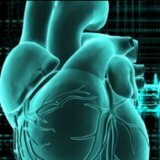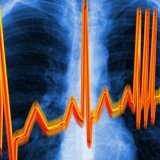Treatment of cardiovascular failure in rheumatism

One has a turbulent and acute process with a large number of symptoms of heart damage, the other - the defeat of the heart is revealed by accident, when the heart disease has already formed.
Causes of cardiovascular failure
Cardiovascular failure in rheumatism causes the following reasons:
- heart valve failure;
- heart rate abnormalities;
- the phenomena of the myocardium - weakness of the heart muscle, difficulty in the work of the heart due to pericarditis, etc.
Treatment of cardiovascular failure
The first step in treatment - and it has long been practiced in rheumatology - bed rest. It would seem that this simple "method" does not require special interpretation, but many patients, especially young people, often do not observe it, sometimes even with the connivance of doctors, "recounting" already when serious complications arise.
The use of cardiac glycosides in rheumatic heart disease complicated by heart failure and in each case is decided individually.
First, the action of cardiac glycosides on the cardiac muscle, susceptible to inflammation, is much weaker than on the myocardium with chronic metabolic disturbances, there are signs of an overdose earlier - violations of the rhythm of the heartbeats.
Secondly, cardiac glycosides exert an irritant effect on the gastrointestinal tract, aggravating the similar irritant effect of the preparations of the main antirheumatic complex.
Given these circumstances, cardiac glycosides are prescribed only with severe heart failure. In other cases, should be limited to the appointment of diuretics. Such therapy can alleviate the condition of a patient with heart failure even without the use of cardiac glycosides, as well as reduce the swelling of the joints. Of the diuretic drugs most commonly used are furosemide and hypothiazide. It should be remembered that diuretics and glucocorticoids lead to a loss of potassium by the body;Therefore, treatment should be carried out under constant ECG monitoring and laboratory potassium content. The reception of potassium preparations - pananginum, asparkam is shown.
Heart rhythm disturbances in rheumatism are a consequence of the inflammatory process in the heart muscle, which leads to its sclerosis and thereby disruption of the conduction of the heart. For the treatment of attacks of arrhythmia - tachycardia, extrasystole, etc., it is first necessary to intensify antirheumatic treatment, applying sufficiently large doses of hormonal drugs and salicylates. Restoration of the heart rhythm is performed with the help of cardiac glycosides, novocainamide, lidocaine, quinidine.
Surgical intervention
For rheumatism, to be more precise, in case of complications, surgical treatment is also used. First of all, this is a surgical correction of heart defects, of which the stenosis of the mitral valve is the main one. Operative intervention on the damaged valve apparatus is performed, with rare exceptions, only in the inactive stage of rheumatism. The presence of arrhythmia is not a contraindication for surgical interventions on the heart. But great importance for the success of the operation has a functional state of the myocardium or, in other words, the degree of damage to the heart muscle by inflammatory and sclerotic changes. Therefore, one of the tasks of a therapist is the timely identification of patients with rheumatism and timely consultation with a cardiac surgeon to resolve the issue of the need for surgical intervention.
There is another complication of rheumatic heart disease requiring urgent surgical intervention. This is an acute obstruction of the intestine by thromboembolism, which detached from the affected heart valve, thromboembolism of the mesentery arteries. Embolus is formed on the valves of the mitral valve during stenosis due to a violation of the rate of blood flow and enters the vessels of the mesentery from the aorta. This is an extremely severe type of arterial disease, in which, if the blood flow is not restored in time, irreversible changes occur in the intestine. The phase of reversible changes lasts 1.5-2 hours;Further gangrene develops in the gut.
Diagnosing this complication is sometimes very difficult. At the patient against a background of its usual condition suddenly there are sharp daggerlike pains in a stomach which do not decrease even at introduction of narcotic analgetics. Collapse may develop;Vomiting is not characteristic. The intensity of pain in the next few hours decreases, because the nerve endings in the affected bowel zone die. Against this background, there are signs of severe intoxication associated with the development of gangrene of the affected bowel and the absorption of degradation products. There is vomiting, there is no peristalsis of the intestine, without leaving the gases, the stool after the enema is bloody, the symptoms of peritonitis are expressed. In this complication, the only measure of saving the patient's life is urgent surgical intervention, which consists in the complete restoration of the arterial blood flow( if possible) or in removing the affected gangrene of the intestine.
Stay healthy!



